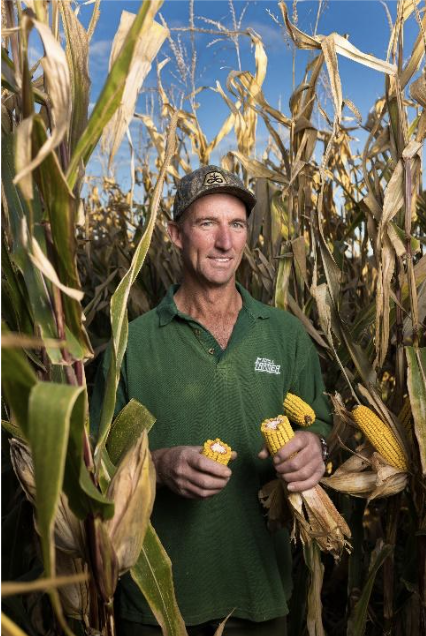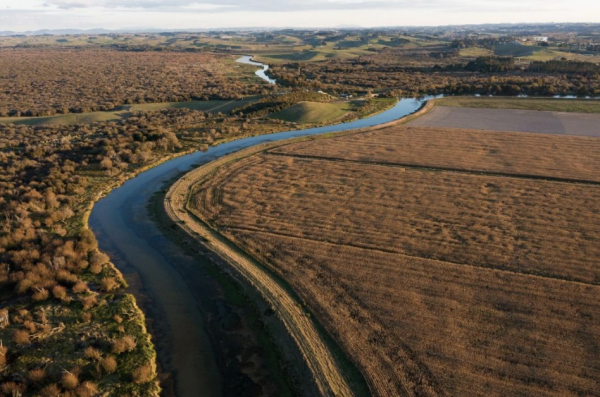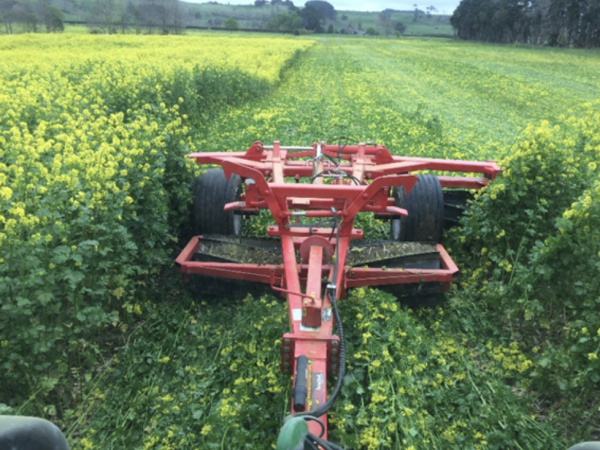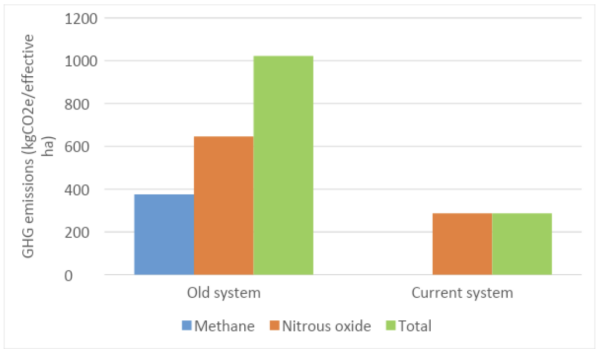Chris Pellow, North Waikato
Chris Pellow crops a total of 122-hectares of land he owns and leases in North Waikato. Each season he grows about 10 hectares of barley and 15 hectares of maize silage. The remaining land is planted in maize grain, with non-harvested cover crops grown in-between.
Video
Overview

The home farm of 28-hectares is located at Onewhero (20 kilometres south of Pukekohe) and has been in the family since 1900. The property was originally a dairy farm. It was then used to run sheep and beef before Chris started growing sweetcorn and pumpkins in the 1990s. Maize was introduced into the system in 1995 and by 2000 the vegetables and livestock had gone. A 66-hectare block at Mercer was running drystock when Chris purchased it in 2013.
Chris started with a traditional maize growing system using conventional cultivation and moderate inputs of synthetic nitrogen. Silage and early harvested grain areas were planted in annual ryegrass which was grazed with cattle. Over the past two decades he has slowly changed to a no-till system where maize is planted in a single pass operation. After silage or grain is harvested, the area is direct drilled into a winter cover crop which is not harvested. Instead, it is rolled and crimped to hasten its breakdown, and the next season’s maize crop is direct drilled into it.
Chris aims to run a system that makes the most efficient use of inputs while maximising crop returns. His long-term average maize grain yield of 12.08 t/ha is around the New Zealand average, however, input costs associated with cultivation and fertiliser are significantly reduced. He has won a number of awards for his farming practices, including the 2022 Arable Awards – Grower of the Year – Maize (see 2022 Award Winners | Arable Awards NZ) and the 2023 Ballance Farm Environment Awards – Waikato (Ballance Agri-Nutrients Soil Management Award; Hill Laboratories Agri-Science Award; Norwood Farm Efficiency Award) see 2023 Award Recipients for the Ballance Farm Environment Awards (nzfeawards.org.nz).
What changes have been made?
Chris started out with a traditional maize growing system, which represents the industry norm. Crops were established using traditional cultivation with moderate to high levels of synthetic nitrogen applied.

Figure 2: Maize grain crop on the Mercer block alongside the Waikato River
Having seen the long-term soil structure damage caused by ploughing, Chris started trialling no-till establishment of maize using his existing equipment. At first he just used the planter he had and started with strips in a paddock. Eventually the area of no-till expanded and as it did, he slowly spent more money on upgrading the planter, making it more “fit for purpose”.
Initially, maize silage crops and any early harvested grain crops were followed by Italian ryegrass, which was grazed in the winter with steers. Chris wasn’t happy with the pugging and soil structure damage, which was significant, even when the livestock were moved three times a day. He says he paid the price the next year with low plant count maize stands due to poor seed-to-soil contact in the pugged areas. He subsequently moved out of grazing livestock into growing cereals for silage after maize silage harvest.
The grain area, which was previously left fallow, was planted in brassicas including mustard and tillage radish. Tillage radish was chosen for its large taproot that can penetrate compacted soil layers. After seeing the benefits of the non-harvested cover crops, including lower fertiliser use and better soil structure, Chris moved towards planting them on the silage area as well.
In the past few seasons, Chris has fine-tuned his system by:
- Planting increasing areas in a legume winter crop mix which can fix nitrogen further, decreasing the need for synthetic nitrogen. This was done to both reduce fertiliser costs but also cut leaching and greenhouse gas (GHG) losses associated with the manufacture and application of synthetic N.
- Crimping and rolling the winter cover crop and then direct drilling the maize into the still live crop residue. The winter crop and any weeds are sprayed out once the maize has been planted. This reduces the number of days the soil is bare and helps reduce nitrogen and organic matter (carbon dioxide) losses.
- Deep N soil testing according to yield zones prior to side dressing. Realistic yield targets (based on long term averages) are used to determine fertiliser nitrogen requirements. Urea is knifed into the soil moisture zone using variable rate fertiliser application technology.

Originally the move to no-till was driven by Chris’s desire to protect the soil structure, which was being affected by a combination of conventional cultivation and pugging by livestock. In recent times this was reinforced by a desire to reduce N losses through leaching and conversion to nitrous oxide. Recent rises in the price of fertiliser and fuel have further reinforced his decision to move to a low fertiliser no-till system.
What have been the impacts of the changes?
Changing crop growing practices have improved soil structure and reduced synthetic nitrogen use significantly.
The changes have helped to lower the cost of production, N fertiliser input per tonne of grain or silage grown, N leaching, GHG emissions, and improve soil structure.
Table 1: Synthetic N applications and N leaching for the old vs current systems on the home farm at Onewhero
| Synthetic N applications (kg N/ha) | N Leaching (kg N/ha) | ||
| Silage | Grain | ||
|
Old system
|
151 | 154 | 38 |
|
Current system
|
104 | 59 | 14 |
GHG emissions were modelled using the Foundation for Arable Research’s E-Check and N leaching using OverseerFM. Livestock methane and greenhouse gas emissions associated with N-fertiliser have reduced by 70 percent since 2010.
Table 2: Total greenhouse gas emissions by gas (calculated using Foundation for Arable Research’s E-Check)
| Old (traditional) system | Current system | Difference | |
| Nitrous oxide (kg CO₂e/ha) | 646 | 287 | -55% |
| Carbon dioxide (kg/ha) | 174 | 76 | -56% |
| Methane (kg CO₂e/ha) | 376 | 0 | -100% |
| Total | 1,196 | 363 | -70% |

Figure 4: GHG emissions by gas (kg CO₂e/effective ha)
By maintaining soil organic matter and using no-till methods to conserve soil moisture, Chris is well placed to handle the changing climate. Variable rate technology allows him to match inputs to the spatial productivity of the soil. For example, he can plant a higher plant population into areas of the paddock which have a higher water holding capacity and conversely, he lowers the plant population in the drier parts of paddocks. His no-till system also allows him to crop near the Waikato River while minimising the risk of weather events creating nutrient run-off.
What process did they go through to make the changes?
Chris worked with industry experts and a cropping consultant. He also read widely about cropping operations in other countries and is part of a group of like-minded reduced-tillage maize growers. He regularly attends any maize grower events offered by industry or the Foundation for Arable Research. He made the changes gradually, starting with small areas. His record keeping is meticulous, and this has allowed him to identify what worked and what didn’t.
Chris is an early adopter of precision agriculture technology, which aims to match crop inputs to spatial productivity. Management zones are determined through electromagnetic mapping, yield mapping, zone soil sampling and remote sensing, including satellite and drone. In addition, he uses variable rate lime, potassium, seed, and nitrogen application. All this allows Chris to map productivity zones accurately within a paddock and determine inputs required to those specific areas.
What other changes are planned?
Chris continues to experiment with cover crop species and mixes. He is currently investigating whether micronutrients can help improve crop yields. He’s also looking at banded fertiliser which aims to concentrate nutrients closer to the root zone, improving application uniformity and nutrient use efficiency.
Chris will continue to focus on anything which will help him to crop more efficiently. This includes improved hybrid genetics, advances in planting and fertiliser application technology.
What advice do they have for other farmers?
Chris’s advice to other farmers who are wanting to develop more environmentally friendly cropping systems and reduce their GHG losses are as follows:
- Have a go, you don’t learn anything by wondering whether you should or shouldn’t try something new.
- Start with a small area, gather lots of data so you can measure the results and see if it has worked.
- Start with your best paddock, not your worst one. A lot of farmers start in their worst paddock, and it is much harder to see a response.
- Look at research, talk to experts and seek out other farmers who are on a similar journey.
Published: July 22, 2025

